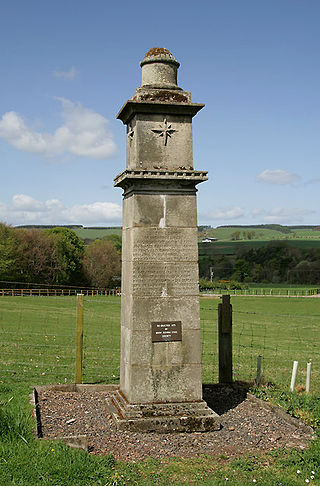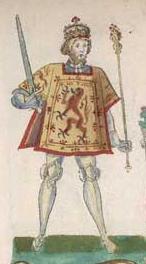
James V was King of Scotland from 9 September 1513 until his death in 1542. He was crowned on 21 September 1513 at the age of seventeen months. James was the son of King James IV and Margaret Tudor, daughter of Henry VII of England. During his childhood Scotland was governed by regents, firstly by his mother until she remarried, and then by his first cousin once removed, John Stewart, Duke of Albany. James's personal rule began in 1528 when he finally escaped the custody of his stepfather, Archibald Douglas, 6th Earl of Angus. His first action was to exile Angus and confiscate the lands of the Douglases.

James IV was King of Scotland from 11 June 1488 until his death at the Battle of Flodden in 1513. He inherited the throne at the age of fifteen on the death of his father, James III, at the Battle of Sauchieburn, following a rebellion in which the younger James was the figurehead of the rebels. James IV is generally regarded as the most successful of the Stuart monarchs. He was responsible for a major expansion of the Scottish royal navy, which included the founding of two royal dockyards and the acquisition or construction of 38 ships, including the Michael, the largest warship of its time.

James III was King of Scots from 1460 until his death at the Battle of Sauchieburn in 1488. He inherited the throne as a child following the death of his father, King James II, at the siege of Roxburgh Castle. James III's reign began with a minority that lasted almost a decade, during which Scotland was governed by a series of regents and factions who struggled for possession of the young king before his personal rule began in 1469.

The Battle of Flodden, Flodden Field, or occasionally Branxton or Brainston Moor was fought on 9 September 1513 during the War of the League of Cambrai between the Kingdom of England and the Kingdom of Scotland and resulted in an English victory. The battle was fought near Branxton, in the county of Northumberland, in northern England, between an invading Scots army under King James IV and an English army commanded by the Earl of Surrey. In terms of troop numbers, it was the largest battle ever fought between the two kingdoms.

Alexander Stewart, Duke of Albany, was a Scottish prince and the second surviving son of King James II of Scotland. He fell out with his older brother, King James III, and fled to France, where he unsuccessfully sought help. In 1482 he invaded Scotland with the army of King Edward IV of England and assumed control of the country. Scottish lords turned against him in 1483 and he fled after King Edward died. The second invasion, in 1484, was not supported by the new English king, King Richard III, and failed. He died in a duel with Louis XII of France, Duke of Orléans, by a splinter from Louis's lance.

Archibald Douglas, 5th Earl of Angus was a Scottish nobleman, peer, politician, and magnate. Tradition has accorded him the nickname Archibald 'Bell-the-Cat' due to his association with the 1482 rebellion against James III of Scotland. He became one of the most powerful nobleman in Scotland through his influential position on the Scottish Marches, and a willingness to be involved in multiple rebellions in the reigns of James III and James IV of Scotland.

Michael, popularly known as Great Michael, was a carrack or great ship of the Royal Scottish Navy. She was the largest ship built by King James IV of Scotland as part of his policy of building a strong Scottish navy.
Robert Lindsay of Pitscottie was a Scottish chronicler, author of The Historie and Chronicles of Scotland, 1436–1565, the first history of Scotland to be composed in Scots rather than Latin.
The Battle of Sauchieburn was fought on 11 June 1488, at the side of Sauchie Burn, a stream about two miles (3 km) south of Stirling, Scotland. The battle was fought between the followers of King James III of Scotland and a large group of rebellious Scottish nobles including the future Alexander Home, 2nd Lord Home, who were nominally led by the king's 15-year-old son, James, Duke of Rothesay. James III was killed in the battle, and his son succeeded him as James IV.

Sir James Hamilton of Finnart was a Scottish nobleman and architect, the illegitimate son of James Hamilton, 1st Earl of Arran, and Marion Boyd of Bonshaw. Although legitimated in 1512 while still a minor, he continued to be known as the "Bastard of Arran". As a key member of the Hamilton family, and second cousin of James V, King of Scotland, he became a prominent member of Scottish society.
William Douglas, 8th Earl of Douglas, 2nd Earl of Avondale was a late Medieval Scottish nobleman, Lord of Galloway, and Lord of the Regality of Lauderdale, and the most powerful magnate in Southern Scotland. He was killed by James II of Scotland.
William Scheves was the second Archbishop of St. Andrews. His parentage is obscure, but he was probably the illegitimate son of a royal clerk, John Scheves. Sixteenth-century accounts claim he spent several years abroad and studied at the University of Louvain. He spent several years at the University of St Andrews as an administrator. In his earlier ecclesiastical career, he had been clericus regiae and master of the hospital of Brechin. In 1474 he was provided unsuccessfully to the Archdeaconry of Dunblane, but by the beginning of 1477 he was Archdeacon of St Andrews and coadjutor (successor) and vicar-general of the archdiocese. After the deposition of Archbishop Patrick Graham in 1478, he succeeded to the archbishopric, apparently receiving the papal pall while in the presence of King James III and many of the nobility at Holyrood.

Clan Cochrane is a Scottish clan of the Scottish Lowlands.

The Treaty of Westminster was signed on 13 February 1462 between Edward IV of England of the House of York and the Scottish John of Islay, Earl of Ross, Lord of the Isles. The agreement proposed that if Scotland was conquered by England, the lands north of the Scottish sea would be divided between the Lord of the Isles and the Earl of Douglas to be held from the crown of England, while the Earl of Douglas would hold Scotland south of the Firth.
George Lauder. was a Scottish prelate and Bishop of Argyll.
In July 1482 an English army invaded Scotland during the Anglo-Scottish Wars. The town of Berwick-upon-Tweed and its castle were captured and the English army briefly occupied Edinburgh. These events followed the signing of the Treaty of Fotheringhay, 11 June 1482, in which Alexander Stewart, Duke of Albany, the brother of James III of Scotland declared himself King of Scotland and swore loyalty to Edward IV of England. The follow-up invasion of Scotland under the command of Edward's brother, Richard, Duke of Gloucester failed to install Albany on the throne, but Berwick has remained English ever since the castle surrendered on 24 August. The English army left Edinburgh with a promise for the repayment of the dowry paid for the marriage of Princess Cecily of England to the Scottish Prince.
The Battle of Lochmaben Fair was an engagement in Lochmaben, Scotland, on 22 July 1484 between Scottish loyalists to James III of Scotland and the rebels Alexander Stewart, Duke of Albany and James Douglas, 9th Earl of Douglas, leading cavalry from England. Both exiles from Scotland, Albany and Douglas invaded with permission but not support of Richard III of England, hoping to encourage rebellion against James. Instead, they were met with armed resistance. The loyalists took the day. Douglas was captured and Albany forced to retreat.

Antoine d'Arcy, sieur de la Bastie-sur-Meylan and of Lissieu, was a French nobleman involved in the government of Scotland.

The Treaty of York (1464) was made between England and Scotland on 1 June 1464 at York and was intended to establish 15 years of peace. Previously Scotland had supported the defeated House of Lancaster in the English civil War of the Roses.
Patrick Lindsay, 4th Lord Lindsay of the Byres was a reputed advisor of James IV of Scotland, and counsellor to Margaret Tudor.












